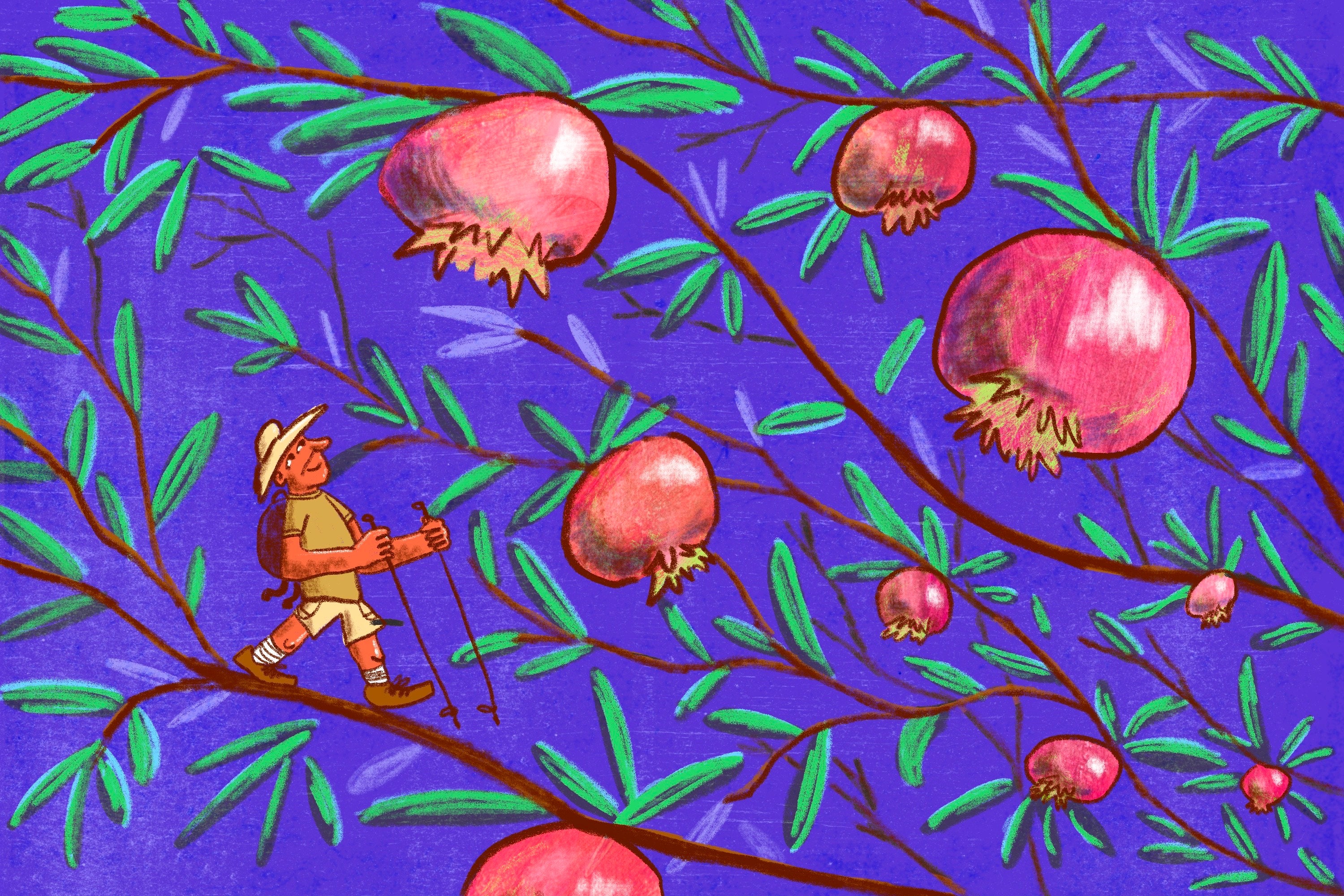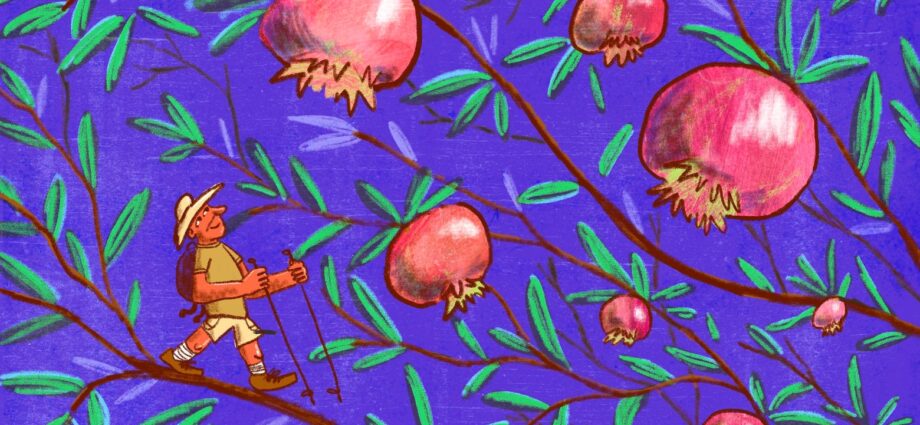All Aboard the Fruit Tourism Train
We travel for all kinds of foods. Why not fruit?

This is part of Fruit Loot, which is taking a look at the strange and surprising links between fruit and money.
How far would you go for fruit?
Whatever your answer, Steven Murray has gone farther. Murray, a farmer of rare fruit in Southern California, has learned 12 languages and traveled to more than 100 countries in search of a juicy bite. “I join different fruit forums in the languages I speak, meet people in those countries, go to their houses, eat fruit,” he told me the other day, taking a break from selling rare cherries at the Santa Monica Farmers Market.
Murray has a special permit to bring small amounts of seeds past U.S. Customs Enforcement, which is how he has amassed, at his Bakersfield family farm, what he says is one of the largest private collections of fruiting plants in the United States. Some, like his cherries, have broad appeal. Then there is the medlar: “Medlars were popular during the Dark Ages, but you have to let them rot to taste good. They’ll be astringent raw; you’ll have to wait.”
Murray is a professional fruit man. But he is part of a ripening trend of fruit travel, as an assortment of vegans, health freaks, farmers, and scientists push gastrotourism beyond familiar trip-generating delicacies like Maine lobster or French Burgundy.
An enterprising fruit-hunter might try Australia’s Feast of the Senses, a tropical fruit festival that among other things set the 2017 Guinness World Record for the longest banana split. Or you could link up with the YouTube fruit celebrities of the FitShortie channel, who run weeklong “fruit retreats” in Indonesia. (First inquiry on the FAQ: “Are we going to eat only fruits during the retreat?” A: You can eat salad in the evenings.) Or you could go to Taiwan, the rare place where the government has tried hard to promote its reputation as the “kingdom of fruit.”
Lindsay Gasik, who spent a year chasing the durian harvest around Southeast Asia and now runs tours in the region, told me these exotic expeditions are merely a twist on more familiar practices, from coffee, wine, or olive oil tastings to apple-picking. “Fruit tourism is very popular already. In the summers, my family always did u-picks at orchards for peaches, berries, apples, or pears. All of this is still fruit tourism.”
And yet some experts say fruit tourism hasn’t quite peaked yet. “This concept has potential,” Bendegul Okumus, a food tourism expert at the University of Central Florida, wrote to me. But it hasn’t sparked much demand: “Unlike wine tourism, fruit tourism is not popular among visitors. … The development of fruit tourism relies on destinations and their producers.” In other words, Okumus suggests, fruit tourism depends not just on fruit nuts like Gasik and Murray, but also on the usual travel-marketing playbook employed by visitors’ bureaus and tourism offices. And here, some of the world’s best fruit is not even on display.
Consider Central Asia, the geographic origin of walnuts, pomegranates, pistachios, and a whole host of stone fruits. Kazakhstan is the ancestral home of the apple, from which the country’s largest city, Almaty, takes its name. As Laura Kiniry wrote in Smithsonian magazine last year, there have been efforts to raise the nation’s international apple profile: “There has also been a successful endeavor to get Almaty Aport apples, a cultivated variety with a honey-like fragrance and sweet and sour flavor … globally recognized as a Kazakh brand, similar to how Parmesan cheese hails from Italy’s Parma-Reggio region, or Champagne from the Champagne wine region of France.” Uzbek authorities have promoted the country’s melons as “the jewel in Uzbekistan’s trading crown.”
But local guides say this effort has not been particularly, uh, fruitful: “When you look at the promotional material of all these countries on social media, it’s never the fruits,” said Saule Kalycheva, the Kazakh co-founder of the Central Asian travel service Caravanistan, who recently organized, with Indira Koshkarbayeva, a four-day wild-apple trip to Kazakhstan’s remote Zhongar-Alatau National Park that drew scientists and other fruiters. Great fruit is a given for the locals, like Kalycheva’s mom, who pressed 10 liters of apple juice this fall from the trees in her yard, but often a sweet surprise to visitors.
Gregory Schaefer runs the culinary tourism company Basque Bites in northern Spain (featuring wine, ham, octopus, and such things). In February, he traveled to Uzbekistan to present on food tourism to professionals from around the region. He tried to lay out what he considers their problem: “Here we are in the middle of the Silk Road; unquestionably every market in Uzbekistan was overflowing with amazing food, not just fruits. And then when you went to a restaurant, you didn’t see any of that, especially vegetables and fruit. Menus at restaurants were incredibly limited, the same four items. The response from locals was: You’re crazy, nobody cares about food. The number one thing their clients were requesting was pizza, hamburgers, and hot dogs.” Despite this bland, low-risk offering, he conceded, Central Asia might just need time to catch up to tourists’ changing tastes.
During his presentation, Schaefer recalled, a Dutch expert on food tourism stood and shouted: “You guys need to honor and cherish your fruit!”
Sure. But part of the problem, explains Robert Spengler, an archaeobotanist and the author of Fruit from the Sands: The Central Asian Origins of the Foods We Eat, is the legacy of the single-minded Soviet focus on cotton production. “Cotton is one of, if not the, most environmentally destructive and least humanitarian crops in the world,” he wrote to me. Cotton has dominated centrally planned agriculture in countries like Uzbekistan, consuming tremendous amounts of water and requiring lots of pesticides. Fruit and nuts are making a planting comeback, but slowly. And because that comeback is mostly geared toward export, visitors in search of fresh produce in places like Kyrgyzstan’s famous Arslanbob walnut forest may be disappointed to find the prime crop boxed and bound for Beijing or Moscow.
“I have no idea why fruit tourism is not a thing, but there is definitely a missed opportunity there,” Spengler continued. One pitfall, he noted, is that the harvest coincides with peak summer temperatures—not an ideal time to visit Uzbekistan’s magnificent Silk Road cities of Samarkand and Bukhara.
More significantly, he said, the tastes of fruit fiends and tree geneticists may not be shared by the general public. “The apples, despite the hype they get for originating in this part of the world, are small and often more sour, which is more true to the ancestral varieties, but my guess is that most tourists would not appreciate the significance.” On the other hand, he had a suggestion: “My favorite Central Asian nut: apricot pits—a special variety of nontoxic roasted apricot pits that taste like almonds, but better.” Try getting that at Trader Joe’s.
Like all adventurous travelers, fruit tourists must be prepared for disappointment. “I’ve spent thousands of dollars to find a fruit,” Murray, the grower of rare fruit, told me. “I really wanted to try the Coco de Mer, the world’s largest seed, from the Seychelles.” Unfortunately for Murray, the Coco de Mer is under strict conservation, and he hit a dead end on the beaches of the Indian Ocean archipelago. But it’s all part of the fun of fruit hunting: “It’s an excuse to go to these regions where you wouldn’t really have a reason to travel.”
Like Bakersfield, where you can stop by Murray Family Farms and try a Buddha’s Hand Fingered Citron and Goat Nipple Berries.
Get the best of news and politics
Sign up for Slate’s evening newsletter.

